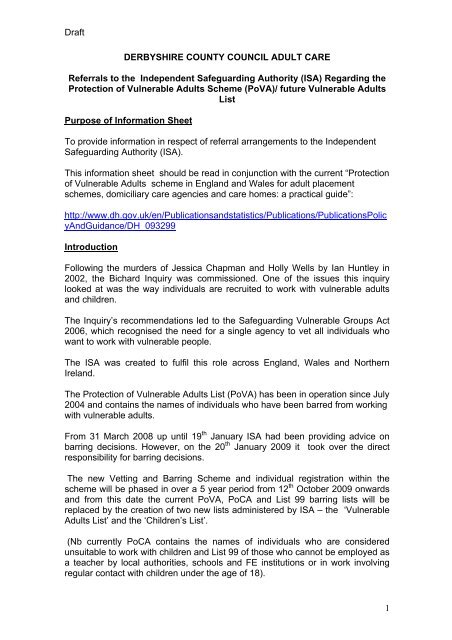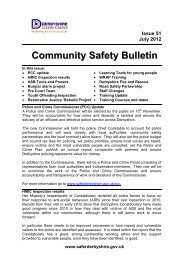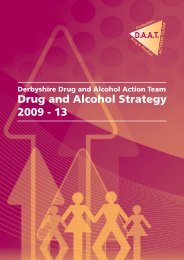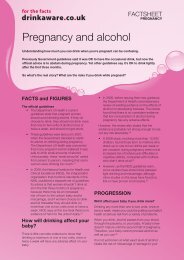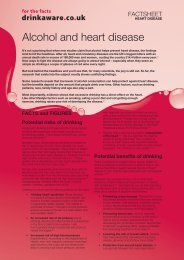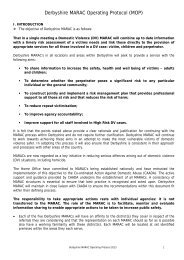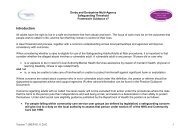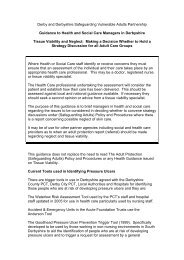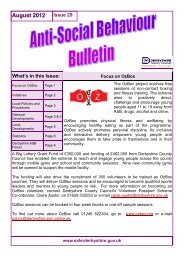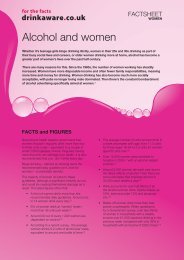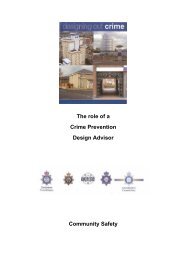Referral to the Independent Safeguarding Authority - Safer Derbyshire
Referral to the Independent Safeguarding Authority - Safer Derbyshire
Referral to the Independent Safeguarding Authority - Safer Derbyshire
Create successful ePaper yourself
Turn your PDF publications into a flip-book with our unique Google optimized e-Paper software.
Draft<br />
DERBYSHIRE COUNTY COUNCIL ADULT CARE<br />
<strong>Referral</strong>s <strong>to</strong> <strong>the</strong> <strong>Independent</strong> <strong>Safeguarding</strong> <strong>Authority</strong> (ISA) Regarding <strong>the</strong><br />
Protection of Vulnerable Adults Scheme (PoVA)/ future Vulnerable Adults<br />
List<br />
Purpose of Information Sheet<br />
To provide information in respect of referral arrangements <strong>to</strong> <strong>the</strong> <strong>Independent</strong><br />
<strong>Safeguarding</strong> <strong>Authority</strong> (ISA).<br />
This information sheet should be read in conjunction with <strong>the</strong> current “Protection<br />
of Vulnerable Adults scheme in England and Wales for adult placement<br />
schemes, domiciliary care agencies and care homes: a practical guide”:<br />
http://www.dh.gov.uk/en/Publicationsandstatistics/Publications/PublicationsPolic<br />
yAndGuidance/DH_093299<br />
Introduction<br />
Following <strong>the</strong> murders of Jessica Chapman and Holly Wells by Ian Huntley in<br />
2002, <strong>the</strong> Bichard Inquiry was commissioned. One of <strong>the</strong> issues this inquiry<br />
looked at was <strong>the</strong> way individuals are recruited <strong>to</strong> work with vulnerable adults<br />
and children.<br />
The Inquiry’s recommendations led <strong>to</strong> <strong>the</strong> <strong>Safeguarding</strong> Vulnerable Groups Act<br />
2006, which recognised <strong>the</strong> need for a single agency <strong>to</strong> vet all individuals who<br />
want <strong>to</strong> work with vulnerable people.<br />
The ISA was created <strong>to</strong> fulfil this role across England, Wales and Nor<strong>the</strong>rn<br />
Ireland.<br />
The Protection of Vulnerable Adults List (PoVA) has been in operation since July<br />
2004 and contains <strong>the</strong> names of individuals who have been barred from working<br />
with vulnerable adults.<br />
From 31 March 2008 up until 19 th January ISA had been providing advice on<br />
barring decisions. However, on <strong>the</strong> 20 th January 2009 it <strong>to</strong>ok over <strong>the</strong> direct<br />
responsibility for barring decisions.<br />
The new Vetting and Barring Scheme and individual registration within <strong>the</strong><br />
scheme will be phased in over a 5 year period from 12 th Oc<strong>to</strong>ber 2009 onwards<br />
and from this date <strong>the</strong> current PoVA, PoCA and List 99 barring lists will be<br />
replaced by <strong>the</strong> creation of two new lists administered by ISA – <strong>the</strong> ‘Vulnerable<br />
Adults List’ and <strong>the</strong> ‘Children’s List’.<br />
(Nb currently PoCA contains <strong>the</strong> names of individuals who are considered<br />
unsuitable <strong>to</strong> work with children and List 99 of those who cannot be employed as<br />
a teacher by local authorities, schools and FE institutions or in work involving<br />
regular contact with children under <strong>the</strong> age of 18).<br />
1
Draft<br />
Locally Derby and <strong>Derbyshire</strong> <strong>Safeguarding</strong> Adults Policy and Procedures<br />
require that <strong>the</strong> chair of both strategy meetings and case conferences address<br />
with employers of implicated staff or managers whe<strong>the</strong>r a referral for inclusion<br />
on <strong>the</strong> PoVA/future Vulnerable Adults List should be made. A referral under<br />
safeguarding will always be made where a referral <strong>to</strong> <strong>the</strong> list is being<br />
considered.<br />
Similar arrangements are mirrored for children through <strong>the</strong> <strong>Derbyshire</strong><br />
<strong>Safeguarding</strong> Children Board and respective barring lists.<br />
<strong>Referral</strong>s <strong>to</strong> ISA<br />
1) What do we mean by a ‘referral’?<br />
This is when information about an individual is passed <strong>to</strong> ISA for considered<br />
inclusion on <strong>the</strong> relevant barring list(s). .<br />
In general terms, if a decision has been made <strong>to</strong> cease using a person’s<br />
services (e.g. dismissed from work) because that person has ei<strong>the</strong>r harmed a<br />
vulnerable adult or child in <strong>the</strong> course of <strong>the</strong>ir work or poses a potential future<br />
risk of harm, <strong>the</strong> matter should be referred <strong>to</strong> ISA.<br />
2) Where should referrals be made <strong>to</strong>? (Please refer <strong>to</strong> page 6 in regards <strong>to</strong><br />
where <strong>to</strong> go for advice before making a referral)<br />
The address <strong>to</strong> where referrals should now be made is:<br />
<strong>Independent</strong> <strong>Safeguarding</strong> <strong>Authority</strong><br />
PO Box 181<br />
Darling<strong>to</strong>n<br />
DL1 9FA<br />
For queries relating <strong>to</strong> PoVA/future Vulnerable Adults List referrals ei<strong>the</strong>r email:<br />
ISADispatchTeam@homeoffice.gsi.gov.uk<br />
or Telephone<br />
01325 953794 or<br />
01325 953757<br />
For queries relating <strong>to</strong> PoCA, List 99 and future Children’s List referrals ei<strong>the</strong>r<br />
email:<br />
ISADispatchTeam@homeoffice.gsi.gov.uk<br />
or Telephone<br />
01325 953795 or<br />
01325 953796<br />
2
Draft<br />
At what point in time should a referral for <strong>the</strong> PoVA/future Vulnerable<br />
Adults List be made <strong>to</strong> ISA?<br />
In general terms a referral should only be made after disciplinary procedures<br />
have been concluded. (Social Care Institute for Excellence (SCIE) guidance<br />
January 2009). This approach has also been reflected within former CSCI<br />
Guidance for Inspec<strong>to</strong>rs – Protection of Vulnerable Adults Scheme.<br />
However, <strong>the</strong> circumstances in which a referral should be made <strong>to</strong> ISA for<br />
considered inclusion on <strong>the</strong> barring list are as follows:<br />
(Nb.<br />
Similar circumstances/considerations apply for those who work with<br />
children and in respect of referrals for inclusion on PoCA, List 99 or future<br />
Children’s barring List)<br />
o <strong>the</strong> provider has dismissed <strong>the</strong> worker on <strong>the</strong> grounds of misconduct<br />
(whe<strong>the</strong>r or not in <strong>the</strong> course of his employment) which harmed (see note<br />
1) or placed at risk of harm a vulnerable adult (see note2 below).<br />
o <strong>the</strong> worker has resigned, retired or been made redundant in<br />
circumstances such that <strong>the</strong> provider would have dismissed <strong>the</strong>m (see<br />
note 3) below , or<br />
o would have considered dismissing <strong>the</strong>m (see note 4 below), on such<br />
grounds if <strong>the</strong>y had not resigned, retired or been made redundant;<br />
o <strong>the</strong> provider has, on such grounds, transferred <strong>the</strong> worker <strong>to</strong> a position<br />
which is not a care position; or<br />
o <strong>the</strong> provider has, on such grounds, suspended (see note 5 below) <strong>the</strong><br />
worker or provisionally transferred <strong>the</strong>m <strong>to</strong> a position which is not a care<br />
position but has not yet decided whe<strong>the</strong>r <strong>to</strong> dismiss <strong>the</strong>m or <strong>to</strong> confirm <strong>the</strong><br />
transfer.<br />
1) What is harm?<br />
“Harm” is defined as “ill treatment or <strong>the</strong> impairment of health or (for those with<br />
conditions relating <strong>to</strong> mental health/learning disability) impairment of<br />
development”.<br />
Harm can include placing vulnerable adults at risk of harm thorough non-action<br />
or neglect or by inciting o<strong>the</strong>rs <strong>to</strong> commit harm.<br />
No secrets: Guidance on policies and procedures <strong>to</strong> protect vulnerable adults<br />
from abuse (Para 2.5) defines abuse as ‘a violation of an individuals human and<br />
civil rights by any o<strong>the</strong>r person or persons’ This may consist of a single act or<br />
repeated acts. Paragraph 2.7 describes different forms of abuse under <strong>the</strong><br />
following headings:<br />
3
Draft<br />
Physical abuse<br />
Sexual abuse<br />
Psychological abuse<br />
Financial or material abuse<br />
Neglect and acts of omission<br />
Discrimina<strong>to</strong>ry abuse<br />
The No Secrets guidance can be found at www.dh.gov.uk/PoVA.<br />
Derby and <strong>Derbyshire</strong>’s Policy and Procedures on <strong>Safeguarding</strong> Adults and<br />
o<strong>the</strong>r information on safeguarding in <strong>Derbyshire</strong> can be found at<br />
http://www.saferderbyshire.gov.uk/staying_safe/protection_of_vulnerable_adults<br />
/<br />
2) Who are vulnerable adults?<br />
The <strong>Safeguarding</strong> Vulnerable Groups Act 2006 defines a vulnerable adult in<br />
section 59 as being someone who has attained <strong>the</strong> age of 18 years and over<br />
and where:<br />
<strong>the</strong>y are in residential accommodation<br />
<strong>the</strong>y are in sheltered housing<br />
<strong>the</strong>y receive domiciliary care<br />
<strong>the</strong>y receive any form of health care<br />
<strong>the</strong>y are detained in lawful cus<strong>to</strong>dy<br />
<strong>the</strong>y are by virtue of an order of a court under supervision by a person<br />
exercising functions for <strong>the</strong> purposes of Part 1 of <strong>the</strong> Criminal Justice and Court<br />
Services Act 2000 (c. 43)<br />
<strong>the</strong>y receive a welfare service of a prescribed description<br />
<strong>the</strong>y receive any service or participate in any activity provided specifically for<br />
persons who fall within subsection (9)<br />
payments are made <strong>to</strong> <strong>the</strong>m (or <strong>to</strong> ano<strong>the</strong>r on <strong>the</strong>ir behalf) in pursuance of<br />
arrangements under section 57 of <strong>the</strong> Health and Social Care Act 2001 (c. 15),<br />
or <strong>the</strong>y require assistance in <strong>the</strong> conduct of <strong>the</strong>ir own affairs.<br />
3) Would have dismissed<br />
This covers a situation where allegations of misconduct (which harmed a<br />
vulnerable adult or placed a vulnerable adult at risk of harm) are made against a<br />
care worker and where <strong>the</strong> individual has, for example, been suspended or<br />
moved <strong>to</strong> a non-care position whilst <strong>the</strong> matter is being investigated by <strong>the</strong><br />
4
Draft<br />
provider. As a result of <strong>the</strong> investigation <strong>the</strong> provider is satisfied that <strong>the</strong> care<br />
worker was guilty of <strong>the</strong> misconduct and that <strong>the</strong>y should <strong>the</strong>refore be dismissed<br />
or moved <strong>to</strong> a non-care position, but, before this decision can be communicated<br />
<strong>to</strong> <strong>the</strong> care worker, resigns or retires.<br />
The point here is that <strong>the</strong> provider has reached <strong>the</strong> conclusion that dismissal<br />
was appropriate in <strong>the</strong> circumstances. The provider can only come <strong>to</strong> this<br />
conclusion because <strong>the</strong>y have completed <strong>the</strong>ir enquiries in<strong>to</strong> <strong>the</strong> allegations.<br />
<strong>Referral</strong>s should be made in <strong>the</strong>se circumstances.<br />
4) Would have considered dismissal<br />
In this situation <strong>the</strong> provider of care has not had <strong>the</strong> opportunity <strong>to</strong> complete <strong>the</strong>ir<br />
investigations in<strong>to</strong> <strong>the</strong> allegations before <strong>the</strong> care worker retires/resigns. Until<br />
<strong>the</strong> provider has completed <strong>the</strong>ir investigations <strong>the</strong>y cannot conclude, with any<br />
degree of certainty, that <strong>the</strong>y would have dismissed <strong>the</strong> care worker. Whilst in<br />
such circumstances <strong>the</strong> provider should attempt <strong>to</strong> undertake all investigations<br />
open <strong>to</strong> <strong>the</strong>m it may not be possible <strong>to</strong> conclude all enquiries. It might prove<br />
impossible <strong>to</strong> interview <strong>the</strong> care worker <strong>the</strong>mselves and <strong>the</strong>refore <strong>the</strong> provider<br />
may only have one side of <strong>the</strong> s<strong>to</strong>ry. In such cases it would be difficult for <strong>the</strong><br />
provider <strong>to</strong> conclude that he would have dismissed <strong>the</strong> care worker. The<br />
provider could only realistically conclude that <strong>the</strong>y would have considered<br />
dismissing <strong>the</strong> care worker.<br />
5) Suspended<br />
Individuals who have been suspended on <strong>the</strong> grounds of harm <strong>the</strong>y have<br />
caused <strong>to</strong> vulnerable adults, but before decisions have been made <strong>to</strong> dismiss or<br />
permanently transfer <strong>to</strong> a non-care position, should be referred <strong>to</strong> ISA for<br />
consideration.. Two points are important here. First, before a care worker is<br />
suspended, <strong>the</strong> provider of care should (so far as possible) take steps <strong>to</strong><br />
establish, as quickly as possible, that <strong>the</strong> allegations of harm have some<br />
element of substance. A precipitate suspension and subsequent referral <strong>to</strong> ISA<br />
that later proves <strong>to</strong> be based on groundless allegations could cause significant<br />
upset and damage <strong>to</strong> <strong>the</strong> care worker and <strong>the</strong>ir working relationship with<br />
colleagues and vulnerable adults. Second, even if a care worker is immediately<br />
suspended because <strong>the</strong> allegations of harm are particularly serious, a referral <strong>to</strong><br />
ISA should only be made if <strong>the</strong> provider of care is reasonably satisfied that <strong>the</strong><br />
allegations have some substance.<br />
Where <strong>the</strong> provider of care has suspended on “neutral” grounds and has not<br />
reached a view on <strong>the</strong> facts, a referral should be deferred until <strong>the</strong> facts have<br />
been established. Social Care Institute for Excellence (SCIE) guidance January<br />
2009.<br />
5
Draft<br />
In respect of <strong>the</strong> existing PoVA scheme which positions are affected?<br />
a) Care workers employed (paid or unpaid) by registered providers of care<br />
homes, including workers supplied by employment agencies and businesses <strong>to</strong><br />
such providers, who are employed in care positions that enable <strong>the</strong>m <strong>to</strong> have<br />
regular contact in <strong>the</strong> course of <strong>the</strong>ir duties with care home residents; and<br />
b) Care workers employed by registered providers who carry on domiciliary care<br />
agencies, including workers supplied by employment agencies and businesses<br />
<strong>to</strong> such providers, who are employed in care positions concerned with <strong>the</strong><br />
provision of personal care in <strong>the</strong>ir own homes for persons who by reason of<br />
illness, infirmity or disability are unable <strong>to</strong> provide it for <strong>the</strong>mselves without<br />
assistance.<br />
c) Adult placement carers.<br />
NB. The PoVA scheme does not apply <strong>to</strong> care workers outside <strong>the</strong> scope of<br />
that listed above. This means that those who work with vulnerable adults in<br />
NHS or independent hospitals, clinics and o<strong>the</strong>r facilities, or through an<br />
independent medical agency, or educational facilities are excluded from <strong>the</strong><br />
ambit of <strong>the</strong> PoVA scheme.<br />
Which posts will be affected after 12 th Oc<strong>to</strong>ber 2009.<br />
Going forward from <strong>the</strong> 12 th Oc<strong>to</strong>ber, 2009 and for <strong>the</strong> purpose of this<br />
information sheet under <strong>the</strong> requirements of <strong>the</strong> <strong>Safeguarding</strong> Vulnerable<br />
Groups Act 2006 <strong>the</strong>re will be a duty <strong>to</strong> refer individuals <strong>to</strong> ISA regarded <strong>to</strong><br />
be undertaking regulated activity – regulated activity being defined as:<br />
1) Any activity of a specified nature that involves contact with vulnerable<br />
adults (or children) frequently, intensively and/or overnight (Such<br />
activities include care, supervision, advice, treatment and transportation)<br />
2) Any activity allowing contact with vulnerable adults (or children) that is a<br />
specified place frequently or intensively. (Such places <strong>to</strong> include care<br />
homes).<br />
‘Frequently’ is defined as once a month or more<br />
‘Intensively’ is defined as where an activity takes place on three or more days in<br />
any 30 day period; or overnight (between 2am and 6am)<br />
More guidance (including sec<strong>to</strong>r specific) is awaited on this area but it is<br />
considered likely that those posts covered under <strong>the</strong> existing PoVA Scheme<br />
referral arrangements will be regarded as positions undertaking regulated<br />
activities and hence subject <strong>to</strong> <strong>the</strong> same referral arrangements.<br />
6
Draft<br />
Where <strong>to</strong> go for advice?<br />
Current and updated ISA referral guidance along with that issued by Department<br />
of Health and <strong>the</strong> Department for Children, Schools and Families is available<br />
through <strong>the</strong> ISA website at:<br />
www.isa-gov.org<br />
In respect of <strong>the</strong> social care setting, detailed and helpful guidance produced by<br />
<strong>the</strong> Social Care Institute for Excellence (SCIE) is also available through <strong>the</strong> ISA<br />
website or is available at:<br />
www.scie.org.uk<br />
O<strong>the</strong>r advice and information – especially that in regards <strong>to</strong> <strong>the</strong> Vetting and<br />
Barring Scheme can be accessed at <strong>the</strong> CRB website at:-<br />
www.crb.gov.uk<br />
Should you have any queries in relation <strong>to</strong> this matter do not hesitate <strong>to</strong> contact<br />
Wendy Holehouse (DCC <strong>Safeguarding</strong> Vulnerable Adults Manager telephone<br />
07500078349 or wendy.holehouse@derbyshire.gov.uk). <strong>Derbyshire</strong> County<br />
Council managers should also contact <strong>the</strong>ir departmental HR.<br />
Andrew Hamble<strong>to</strong>n Project Manager <strong>Safeguarding</strong><br />
David Ingham Senior HR Consultant (Adult Care)<br />
7


